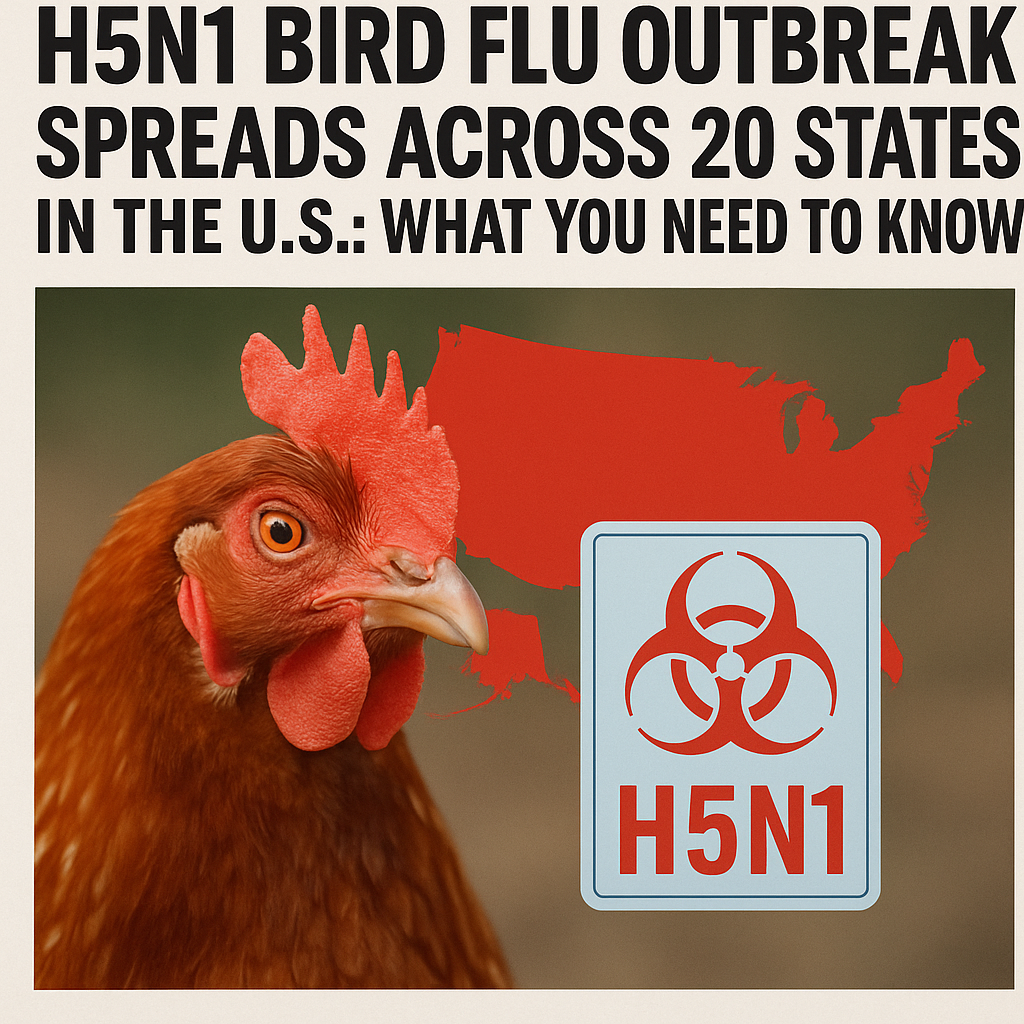In recent weeks, an alarming resurgence of the H5N1 avian influenza (bird flu) has begun spreading across the United States, affecting at least 20 states. This latest outbreak is sparking concerns among public health experts, as the virus poses a serious threat to both animal and human health. While human infections remain rare, the rapid spread of the virus among wild birds and poultry has raised the potential for future risks.
Here’s what we know so far about the current H5N1 outbreak, the implications for public health, and the steps you can take to protect yourself and your community.
What is H5N1 Bird Flu?
H5N1 is a strain of avian influenza, a highly contagious viral infection that primarily affects birds. It can, however, be transmitted to humans and other animals in rare cases. The virus is notorious for its potential to mutate and evolve into forms that are more easily transmissible between humans. This is why health officials remain vigilant when outbreaks occur, despite the fact that the majority of infections still occur in animals.
The virus is typically spread through direct contact with infected birds or their droppings, and humans can become infected through handling infected animals, consuming contaminated poultry products, or being in close proximity to infected environments.
Why is the Current Outbreak Worrying?
While H5N1 outbreaks are not new, the recent spread of the virus across 20 states in the U.S. is particularly concerning due to several factors:
-
Increased Animal-to-Animal Transmission: H5N1 has been circulating among wild birds and poultry populations, causing significant mortality rates. This increased transmission among animals raises the likelihood of the virus mutating into a form that could pose a greater risk to humans.
-
Global Spread: The virus has already spread across multiple continents, with cases reported in Europe, Asia, and the Middle East. This global reach means that control efforts must be more coordinated, and public health systems need to be prepared for a potentially larger-scale pandemic scenario.
-
Human Infections: Though human infections are still relatively rare, recent cases in Asia and Europe have raised concerns. Health experts warn that any mutation that enables easier human-to-human transmission could lead to a more widespread outbreak, with potentially devastating consequences.
-
Impact on Poultry Industry: The poultry industry has already been severely impacted, with millions of chickens and turkeys being culled to prevent the spread of the virus. This has caused disruptions in food supply chains, with prices for poultry products rising and fears about long-term food security.
How Does H5N1 Spread?
The virus spreads primarily through direct contact with infected birds, especially their saliva, nasal secretions, and feces. It can also be transmitted indirectly through contaminated feed, equipment, or clothing. This is why poultry farms, as well as live bird markets, are considered high-risk environments for an outbreak.
Human infections occur in very rare instances, often involving close contact with infected birds or contaminated environments. The virus does not currently spread easily between humans, but scientists are concerned that it could mutate in the future to become more transmissible.
What Are Public Health Experts Doing?
Health and agriculture authorities are working around the clock to contain the spread of H5N1. Key actions being taken include:
-
Surveillance and Monitoring: Public health agencies, such as the CDC and the World Health Organization (WHO), are closely monitoring the virus’s spread in both animals and humans. Surveillance in wildlife populations and commercial poultry farms is being ramped up to detect and contain any new cases early on.
-
Culling Infected Birds: Infected poultry is being culled to limit the virus’s spread. This is an important strategy to prevent the virus from jumping to humans or further contaminating food supplies.
-
Vaccination: Vaccines for H5N1 are being tested and distributed for both humans and animals, particularly for poultry. While not a cure-all, vaccination efforts can help reduce the transmission of the virus and prevent major outbreaks.
-
Public Awareness: Health authorities are urging individuals in affected areas to avoid contact with sick or dead birds and to practice good hygiene, including frequent handwashing and wearing protective clothing when handling poultry.
What Should You Do to Stay Safe?
If you live in an area affected by the H5N1 outbreak, there are several steps you can take to protect yourself:
-
Avoid Contact with Birds: If you see dead or sick birds, especially in wild bird populations, avoid touching them. Contact local wildlife authorities to report sightings.
-
Practice Good Hygiene: If you work with poultry or in environments where birds are kept, wash your hands frequently and wear protective gear, such as gloves and masks, when handling birds.
-
Cook Poultry Thoroughly: H5N1 is killed by heat, so ensuring that all poultry is cooked to a safe internal temperature (165°F or 74°C) will reduce the risk of transmission through consumption.
-
Monitor for Symptoms: Symptoms of H5N1 in humans are similar to other flu strains and include fever, cough, sore throat, and muscle aches. If you suspect you’ve been exposed to the virus, seek medical attention promptly.
Looking Ahead
While the current H5N1 outbreak is still in its early stages in the U.S., it serves as a stark reminder of the ongoing threat posed by zoonotic diseases—those that spread between animals and humans. Public health officials will continue to monitor the situation, with hopes that swift action will prevent the virus from mutating into a more serious global threat.
The situation also highlights the importance of global cooperation in managing outbreaks, as well as the need for strong surveillance systems, effective vaccines, and rapid-response strategies to combat emerging viruses.

